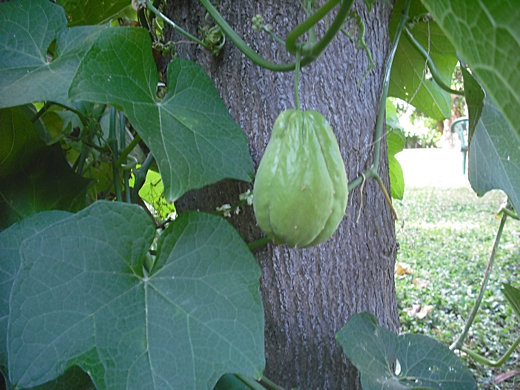By Linda Pascatore on 14 June 2010 for Island Breath -
(http://islandbreath.blogspot.com/2010/06/chayote.html)

Image above: Fruit of chatoye hangs on vine climbing mature haoli koa tree in Hanapepe Valley. Photo by Linda Pascatore.
About six months ago, a friend brought a squash dish to a potluck, and gave us the small green pear-shaped Chayote squash to grow. She said one plant had produced over a hundred squash. The base of the squash was beginning to sprout, so we stuck it in a pot of dirt. It soon rooted and sent out a vine that began to climb up the railing on our deck. We planted it near a mature haoli koa tree, and then it really took off. The chayote plant grew quickly and easily, vining and producing lots of leaves. Within a couple of months of outplanting, we had small squash. We made a delicious sauteed dish. In taste and texture, Chayote is similar to a zucchini or yellow crook necked squash. We have not had much luck in growing other varieties of squash here, as they are usually attacked by wasps before the fruit ever ripens. We were delighted to find a squash so prolific and easy to grow here on the west side of Kauai.
Appearance:
Chayote (Sechium edule) is a member of the gourd family and related to squash, melons, and cucumbers. The fruit, or squash, is pear shaped with creases, and grows 4 to 8 inches in length. Different varieties can range in skin color from dark green to white, with pale green or white flesh. The skin is soft and fused to the flesh, and can have some small spikes. There is a single seed which is a soft flattened pit in the center of the fruit. Leaves are large and heart shaped, and the stem has tendrils that cling to climb up a trellis or tree. The vine can climb up to 40 feet high. Flowers are cream colored or light green.
Origin:
Chayote probably originated in Meso-America, and was cultivated there in pre-Columbian times. The greatest variety of cultivars and wild relatives of the plant are found from Southern Mexico through Guatemala. After Western contact, the plant was distributed during the 18th and 19th centuries throughout the Americas, Europe, Africa, and Asia. It is easily cultivated in many warm climates throughout the world.
Names:
Chayote is the Spanish name of the plant, and it is derived from the Nahual word Chayotli. The plant is also known as Chouchou in Africa, Christophene in France, Pataste in Guatemala, Mirliton in Lousiana, a word meaning “Budha Hand Melon” in China, a word meaning “Dragon Whisker Vegetable” in Taiwan, and Seemae BaDhneKayi in India.
Uses:
Chayote is high in carbohydrates, Vitamin C, and amino acids. Although the fruit is most commonly consumed, all parts of the Chayote plant are edible. The starchy root can be cooked like a yam or potato, and is also used as fodder for pigs or cattle. The leaves can be brewed in a tea, and young shoots are used in Thai stir fried dishes. Chayote is dried in Mexico, and has been used in jams. The fruit can be eaten raw or cooked.
Preparation:
A word of caution: the first time I peeled a chayote, I thought that it had somehow caused my hands to chap and peel. However, it was substance on the squash which coated my hands and then peeled off, similar to Elmer’s glue dried on your hands. The way to avoid this is to peel the fruit under water or oil your hands before peeling. Peel the fruit, halve it and remove the seed . If you want to use the fruit raw, you may want to soak it in a little lime or lemon juice before adding to a salad.
Recipes:
Sauteed Chayote: Peel and slice Chayote and saute with butter or oil with onions and garlic. Season with salt and pepper. Chayote Potato Salad: Cut Chayote into cubes, and boil until fork tender. Drain and place in a bowl with chopped onions, celery, green pepper, and garlic. Add chopped boiled egg. Mix with mayonnaise and mustard to taste, and season with salt, pepper and dill. For a PDF (8mb) file of more info on raising and preparing chayote: (www.islandbreath.org/2012Year/04/120401chayote.pdf)
.
2 comments :
YUM!! Having some this morning with my eggs!! I sauteed it up!! Onolicious!!
Aloha Top Hat,
I just made some corn beef n' taro as a side dish for a couple of backyard eggs sunny side up.
Yum!
Juan
Post a Comment